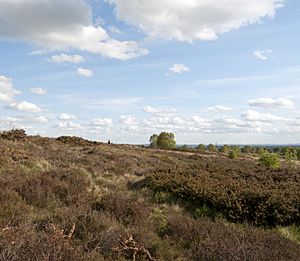Gentleshaw Common facts for kids
| Site of Special Scientific Interest | |
 |
|
| Area of Search | Staffordshire |
|---|---|
| Coordinates | 52°41′53″N 1°55′34″W / 52.698°N 1.926°W |
| Interest | Biological |
| Area | 212.5 acres (0.86 km2; 0.33 sq mi) |
| Notification | 1981 |
Gentleshaw Common is a special area of land in Staffordshire, England. It's located near the village of Gentleshaw and the town of Burntwood. This common land is very important because it's home to a rare type of habitat called lowland heathland.
Because of its unique nature, Gentleshaw Common has been named a Site of Special Scientific Interest (SSSI). This means it's protected to help keep its plants and animals safe. People can visit the common and enjoy nature walks and other outdoor activities throughout the year.
Contents
Where is Gentleshaw Common?
This special area covers about 212.5 acres (or 86 hectares). It sits on the western side of a small hill. This hill is part of the southern slope of the Cannock Chase plateau.
The common is southwest of Gentleshaw village. It looks out over the town of Burntwood to the south. The land gently slopes downwards. It goes from about 206 meters (676 feet) high in the northeast to 150 meters (492 feet) high at its southern edge.
The Ground Beneath Your Feet
The ground at Gentleshaw Common has special layers of soil and rock. The top layer is made of gravelly boulder clay. Below that is a type of rock called Triassic Keuper Sandstone.
These layers have created a unique kind of soil. It's weathered, meaning it's been broken down over time. It's also acidic and doesn't have many nutrients. This special soil is perfect for the rare plants that grow here.
A small stream called Redmoor Brook starts in the southwest part of the common. It flows eastwards and eventually joins the River Trent.
What Plants Grow Here?
Gentleshaw Common is famous for its lowland heathland plants. This type of habitat is rare in Staffordshire. That's why it's protected as a Site of Special Scientific Interest (SSSI). It's also a Site of Biological Importance (SBI).
The plants here are a mix of different types. Some are found in wet, cool areas, and others like warmer, sunny spots. The common also has areas that change from dry to humid and even wet heathland.
Dry Heathland Plants
Most of the common has soil that drains water easily. This creates a dry heathland. Here, you'll find plants like heather and wavy hair grass. Other common plants include bilberry, mat grass, and cowberry.
What makes Gentleshaw Common special is its low height and sunny southern side. This allows plants usually found in warmer western parts of Britain to grow here. For example, you'll see lots of bell heather and western gorse.
Humid and Wet Heathland Plants
In the southern part of the common, the soil doesn't drain water as well. This creates a humid heathland. Here, you can find purple moor-grass and cross-leaved heath. Other plants include heath rush, compact rush, green-ribbed sedge, and crowberry.
There's also a shallow valley that drains into Redmoor Brook. This area has peat soils, which are very wet. Rare wet heathland plants thrive here. These include bog mosses, common cotton grass, star sedge, round-leaved sundew, cranberry, and bog asphodel.
What Animals Live Here?
While the plants are very diverse, the animal life at Gentleshaw Common is also interesting. You might spot a meadow pipit, which is a small bird. Common lizards, a type of reptile, also live here. If you're lucky, you might even see a green hairstreak butterfly.

